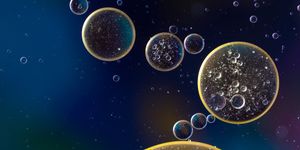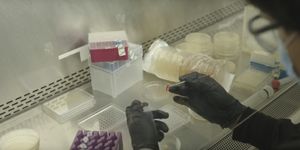First ever documented liquid-to-liquid transition in sulfur
New research published in Nature documents evidence for a liquid-to-liquid transition in sulfur, a first-order phase transition that has been enigmatic to chemists. The original first-order transition separating two liquid phases of the same pure and isotropic substance was reported in a 2000 Nature publication documenting Y. Katayama et al.’s discovery of a liquid-to-liquid transition undergone in phosphorus. This recent study builds on that work.
"It was a real breakthrough, as it changed the way the liquid state was perceived by the scientific community", explains the corresponding author of the new study, Mohamed Mezouar, who is a scientist in charge of beamline ID27 at the ESRF. "Today we show the second direct evidence of such a transition in liquid sulfur. We chose sulfur because sulfur and phosphorus exhibit important similarities when subjected to high pressures and temperatures", he explains. "Besides, I knew it was a good candidate as it already showed an interesting variety of solid forms, either molecular or polymeric, crystalline or amorphous.”
First-order transitions refer to phase transitions that involve a latent heat and a discontinuous change of density, for example from graphite to diamond. They are very common in solid states but this is only the second document first-order transition from liquid to liquid. Watch the video below to see it happening.
In conducting this experiment, the ESRF team applied pressure to liquid sulfur and watched how it evolved under temperatures up to 1000 degrees Celsius and pressures up to 20 kilobars. "The experiments were challenging because we had to confine liquid sulfur and perform in situ quantitative X-ray measurements of high accuracy", explains first author Laura Henry.
And as if that weren’t enough, that’s not all the ESRF, CEA and CNRS/Sorbonne Université scientists found! They also documented the critical point terminating a liquid-liquid transition, which up until now was a mere theoretical object.
Fréderic Datchi, CNRS research director at "Sorbonne Université" describes: "Completely unexpectedly, there it was, we found what we know as a 'critical point', a singularity where physical properties change drastically". As Eureka Alert elaborates, “the change in density between the two liquids vanishes [at the critical point], thus one may go continuously from one phase to the other. However, close to it, the system "hesitates" between the two states, producing large density fluctuations, a phenomenon known as critical opalescence.”
These two findings were enough to make the researchers jump for joy because understanding this liquid-liquid transition will allow for new developments in materials science. Sulfur has many applications; already it is used in rubber tires, sulfuric acid, and fertilizers, among others. Furthermore, adds Mezouar, "In the larger sense, this research can open doors to understanding the complexity of the liquid state of other important systems such as water."
Sources: Nature, Eureka Alert








